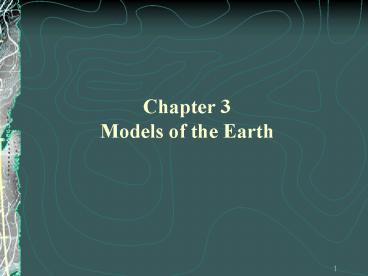Chapter 3 Models of the Earth PowerPoint PPT Presentation
1 / 16
Title: Chapter 3 Models of the Earth
1
Chapter 3Models of the Earth
2
3-1 Modeling the Planet
- A. Maps
- a. Map-A flat, two-dimensional representation
of Earths surface. - b. Cartographers-A mapmaker who has devised
tools to help a map user relate two-dimensional
images on a map with the three-dimensional world.
3
3-1 Modeling the Planet
- B. Map Projections
- a. Projections-To reduce distortion,
cartographers draw world maps in three different
ways. - b. Mercator-Depicts the earth as if it had been
projected onto a large cylinder and then
unwrapped. Areas at the poles are distorted in
this projection.
4
3-1 Modeling the Planet
- B. Map Projections
- c. Gnomonic Projection- This projection is
made as if a sheet of paper had been laid out on
a given point on the earths surface. This
projection distorts landmass shapes. - d. Polyconic Projection- In this projection it
is as if a cone of paper has been wrapped around
the earth. Lines of latitude and longitude are
curved slightly. Most landforms have their true
shape.
5
3-1 Modeling the Planet
- C. Latitude and Longitude
- a. A grid of imaginary lines placed on the
earth. - b. The earth is divided into Hemispheres. The
Equator is the imaginary line dividing the north
from the south. The Prime Meridian divides east
and west.
6
3-1 Modeling the Planet
- c. The equator is a latitude line that circles
the world from east to west. Latitude is
measured in degrees north and south. - d. The prime meridian is a longitude line that
runs from north to south. It is measured in
degrees east and west.
7
3-1 Modeling the Planet
- D. Map Scales
- a. The scale on a map tells you how the maps
features compare in size with the earths
surface. - b. This is depicted using a ratio. Ex. one
inch equals one mile. - E. Map Orientation
- a. Always locate north. On new maps it is
always on top. East is on the right, west on the
left and south on the bottom.
Compass Rose
N
E
W
S
8
3-2 Mapmaking and Technology
- A. How Cartographers Traditionally Worked
- a. The USGS created its first map in 1879.
Its main purpose was to survey and map the West. - b. Plane Table Surveying was the technique
originally used. This technique involved
carrying a plane table to the highest vantage
point and drawing a map of whatever features they
could see.
9
3-2 Mapmaking and Technology
- B. How Technology Has Changed in Mapmaking
- a. The use of airplanes, cameras and radar
advanced mapmaking tremendously. Why? - C. Satellite Technology
- a. In 1972 NASA launched the first Landsat
satellite into space. - b. False color Image-made up of colors that
represent images collected by the satellite. - c. Provide a larger view of the
earths features
Because you could see the land from above
10
3-2 Mapmaking and Technology
- D. Computer Technology
- a. Computers are needed to process the images
collected by satellites. Advances in computer
technology have made it easier and faster to
process this information.
11
3-2 Mapmaking and Technology
- b. Global Positioning System (GPS)-Allows people
to determine their position, speed, and time
anywhere in the world. - c. Triangulates its position using the
satellites in the sky. - d. Geographic Information Systems
(GIS)-Combines satellite images and surveys. See
page 52.
12
3-3 Topographic Maps
- A. Qualities of Topographic Maps
- a. Depicts the features of an area using
contour lines and symbols. - b. 7.5 maps-represent 7.5 minutes of latitude
by 7.5 minutes of longitude. - c. Why are these maps important?
They show us the location and elevation of
landmarks
- http//erg.usgs.gov/isb/pubs/booklets/symbols/
13
3-3 Topographic Maps
- A. Qualities of Topographic Maps
- d. Contour Lines- Narrow brown lines on
topographic maps that indicate the landscapes
elevation. They connect points of the same
elevation.
14
3-3 Topographic Maps
The contour interval can be calculated by taking
the difference in the two bold lines and dividing
by 5. Ex. (800ft-700ft)/520 ft
- e. Contour Interval- The difference in elevation
between two consecutive contour lines. - f. Contour lines that are close together
indicate steep terrain lines that are far apart
indicate a gentle slope.
15
3-3 Topographic Maps
- B. Understanding Topographic Map Symbols
- a. These symbols help to understand what
features are on the map. See page 697. - b. Magnetic Declination- Angle by which a
compass needle will vary from true north.
16
3-3 Topographic Maps
- C. Using Topographic Maps
- a. Shape of the land can be determined by
making a profile from a topographic map. See
page 57. - b. A map scale indicates how much land is being
covered in a given area on the map.

